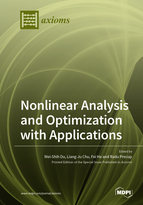Nonlinear Analysis and Optimization with Applications
A special issue of Axioms (ISSN 2075-1680). This special issue belongs to the section "Mathematical Analysis".
Deadline for manuscript submissions: closed (31 December 2020) | Viewed by 25090
Special Issue Editors
Interests: nonlinear analysis and its applications; fixed point theory; variational principles and inequalities; optimization theory; equilibrium problems; fractional calculus theory
Special Issues, Collections and Topics in MDPI journals
Interests: nonlinear analysis and its applications; fixed point theory; variational principles and inequalities; optimization theory; equilibrium problems
Interests: nonlinear boundary value problems for ODEs and PDEs; theory of nonlinear operators; topological fixed point theory; critical point theory; mathematical modeling in biology and medicine
Special Issues, Collections and Topics in MDPI journals
Special Issue Information
Dear Colleagues,
Nonlinear analysis has wide and significant applications in many areas of mathematics, including functional analysis, variational analysis, nonlinear optimization, convex analysis, nonlinear ordinary and partial differential equations, dynamical system theory, mathematical economics, game theory, signal processing, control theory, data mining, and so forth. Optimization problems have been intensively investigated, and various feasible methods in analyzing convergence of algorithms have been developed over the last half century. In this Special Issue, we will focus on the connection between nonlinear analysis and optimization as well as their applications to integrate basic science into the real world.
We cordially and earnestly invite researchers to contribute their original and high-quality research papers which will inspire advances in nonlinear analysis, optimization, and their applications. Potential topics include but are not limited to:
- Functional analysis;
- Critical point theory;
- Bifurcation theory;
- Set-valued analysis;
- Calculus of variations and PDEs;
- Variational and topological methods for ODEs and PDEs;
- Fxed point, coincidence point, and best proximity point theory;
- Nonsmooth analysis and optimization;
- Graph theory and optimization;
- Game theory;
- Convex analysis;
- Matrix theory;
- Control theory;
- Inverse and ill-posed problems;
- Finite element method;
- Dynamical systems;
- Image and signal processing;
- Data mining
Prof. Dr. Wei-Shih Du
Prof. Dr. Liang-Ju Chu
Prof. Dr. Fei He
Prof. Dr. Radu Precup
Guest Editors
Manuscript Submission Information
Manuscripts should be submitted online at www.mdpi.com by registering and logging in to this website. Once you are registered, click here to go to the submission form. Manuscripts can be submitted until the deadline. All submissions that pass pre-check are peer-reviewed. Accepted papers will be published continuously in the journal (as soon as accepted) and will be listed together on the special issue website. Research articles, review articles as well as short communications are invited. For planned papers, a title and short abstract (about 100 words) can be sent to the Editorial Office for announcement on this website.
Submitted manuscripts should not have been published previously, nor be under consideration for publication elsewhere (except conference proceedings papers). All manuscripts are thoroughly refereed through a single-blind peer-review process. A guide for authors and other relevant information for submission of manuscripts is available on the Instructions for Authors page. Axioms is an international peer-reviewed open access monthly journal published by MDPI.
Please visit the Instructions for Authors page before submitting a manuscript. The Article Processing Charge (APC) for publication in this open access journal is 2400 CHF (Swiss Francs). Submitted papers should be well formatted and use good English. Authors may use MDPI's English editing service prior to publication or during author revisions.
Keywords
- Functional analysis
- Critical point theory
- Bifurcation theory
- Set-valued analysis
- ODEs and PDEs
- Fxed point, coincidence point, and best proximity point theory
- Nonsmooth analysis
- Convex analysis
- Matrix theory
- Control theory
- Dynamical systems
- Image and signal processing
- Data mining
- Graph theory and optimization






